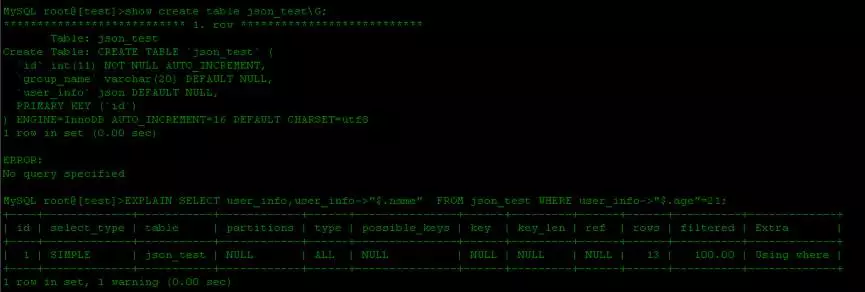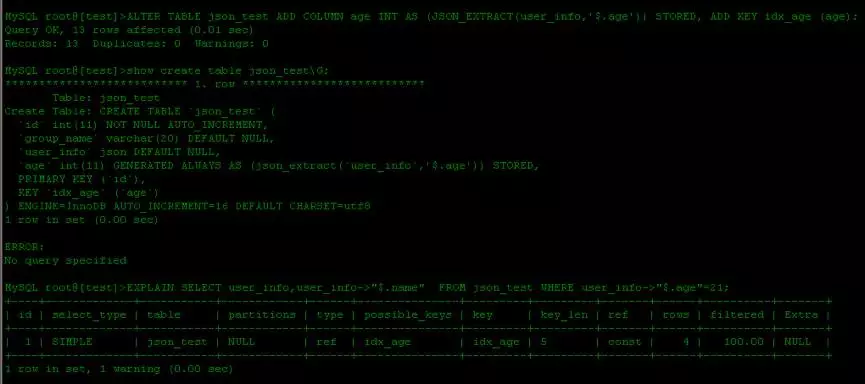MySQL 5.7 new features | Json Column and Generated Column (Part 2)
The JSON field type does not have its own index in the current version, so it is very terrible in production. The efficiency of adding, deleting, modifying, and checking JSON fields can be imagined, and it is basically unusable. Maybe it is based on this. MySQL5.7 provides a Generated field type, which is called generated column or calculated column on the Internet. Let’s first understand what Generated Column is.
1. Introduction to Generated Column
Generated Column is a new feature introduced in MySQL 5.7.6. The so-called Centerated Column means that this column in the database is calculated from other columns. To illustrate, quote the example in the official reference manual:
CREATE TABLE triangle ( sidea DOUBLE, sideb DOUBLE, sidec DOUBLE AS (SQRT(sidea * sidea + sideb * sideb)) ); INSERT INTO triangle (sidea, sideb) VALUES(1,1),(3,4),(6,8); mysql> SELECT * FROM triangle; +-------+-------+--------------------+ | sidea | sideb | sidec | +-------+-------+--------------------+ | 1 | 1 | 1.4142135623730951 | | 3 | 4 | 5 | | 6 | 8 | 10 | +-------+-------+--------------------+
There are two types of Generated Column, namely Virtual Generated Column and Stored Generated Column. The former only saves Generated Column in the data dictionary (metadata of the table), and This column of data will not be persisted to disk; the latter will persist the Generated Column to disk instead of calculating it each time it is read. Obviously, the latter stores data that can be calculated from existing data, requires more disk space, and has no advantage over Virtual Column. Therefore, in MySQL 5.7, the type of Generated Column is not specified, and the default is Virtual Column. Although Virtal Generated Column should generally be used, there are currently many restrictions on using Virtual Generated Column: it cannot be used as a primary key, cannot be used as a primary key, cannot create full-text indexes and spatial indexes, etc., but it may be supported in subsequent versions. Therefore, if you use Generated Column fields for indexing, you should use Stored Generated Column. When using Generated Column for indexing, the official solution for JSON field indexing is to use Stored Generated Column. The table creation statement using Stored Generated Column is as follows, just adding a word:
CREATE TABLE triangle ( sidea DOUBLE, sideb DOUBLE, sidec DOUBLE AS (SQRT(sidea * sidea + sideb * sideb) STORED) );
2. Notes on Generated Column
Generated Column cannot be written, it is automatically generated; When creating, you must consider whether the calculation formula of this column is reasonable. If it is unreasonable, no error will be reported when creating it, but an error will be reported when inserting a value when using it. The columns that Generated Column depends on will prompt an error when deleting, and Generated Column must be deleted first. Only then can we delete the columns it depends on; the definition of Generated Column is illegal. For example, if we define generated column as "column x + column y", it is obvious that column x or column y are both numerical. If we define column x or column y If the column is defined (or modified) as character type, an error is expected, but in fact we can create it normally, but an error will be reported when inserting.

3. Use Generated Column to add an index to the JSON field
Normally, the query related to the JSON field scans the entire table, because the JSON field itself If the index cannot be created, we use the Generated Column feature to generate columns for the relevant keys in the JSON field as Generated Column, and then index the Generated Column:
ALTER TABLE json_test ADD COLUMN age INT AS (JSON_EXTRACT(user_info,'$.age')) STORED, ADD KEY idx_age (age);
The before and after comparison is as follows:


#It can be clearly seen that after using Generated Column and adding an index, the index is used to query the value in the JSON field.
Conclusion
The emergence of Generated Column and JSON Column in MySQL5.7 makes it possible to replace NoSQL such as MongoDB in some scenarios, although overall it has not been done by MongoDB and others. is so powerful, but I believe that there will be more and more scenarios in which these two types are used in the future. At the same time, the challenges to DBA will also become greater and greater. It is hoped that intensive use of JSON type business will be run using independent MySQL instances to prevent JSON from becoming a large field. (The size of the JSON column stored in the JSON document is limited to the value of the max_allowed_packet system variable) This has an impact on other operations.
The above is the content of MySQL 5.7 new features | Json Column and Generated Column (Part 2). For more related content, please pay attention to the PHP Chinese website (www.php.cn)!

Hot AI Tools

Undresser.AI Undress
AI-powered app for creating realistic nude photos

AI Clothes Remover
Online AI tool for removing clothes from photos.

Undress AI Tool
Undress images for free

Clothoff.io
AI clothes remover

Video Face Swap
Swap faces in any video effortlessly with our completely free AI face swap tool!

Hot Article

Hot Tools

Notepad++7.3.1
Easy-to-use and free code editor

SublimeText3 Chinese version
Chinese version, very easy to use

Zend Studio 13.0.1
Powerful PHP integrated development environment

Dreamweaver CS6
Visual web development tools

SublimeText3 Mac version
God-level code editing software (SublimeText3)

Hot Topics
 MySQL's Role: Databases in Web Applications
Apr 17, 2025 am 12:23 AM
MySQL's Role: Databases in Web Applications
Apr 17, 2025 am 12:23 AM
The main role of MySQL in web applications is to store and manage data. 1.MySQL efficiently processes user information, product catalogs, transaction records and other data. 2. Through SQL query, developers can extract information from the database to generate dynamic content. 3.MySQL works based on the client-server model to ensure acceptable query speed.
 How to start mysql by docker
Apr 15, 2025 pm 12:09 PM
How to start mysql by docker
Apr 15, 2025 pm 12:09 PM
The process of starting MySQL in Docker consists of the following steps: Pull the MySQL image to create and start the container, set the root user password, and map the port verification connection Create the database and the user grants all permissions to the database
 Laravel Introduction Example
Apr 18, 2025 pm 12:45 PM
Laravel Introduction Example
Apr 18, 2025 pm 12:45 PM
Laravel is a PHP framework for easy building of web applications. It provides a range of powerful features including: Installation: Install the Laravel CLI globally with Composer and create applications in the project directory. Routing: Define the relationship between the URL and the handler in routes/web.php. View: Create a view in resources/views to render the application's interface. Database Integration: Provides out-of-the-box integration with databases such as MySQL and uses migration to create and modify tables. Model and Controller: The model represents the database entity and the controller processes HTTP requests.
 Solve database connection problem: a practical case of using minii/db library
Apr 18, 2025 am 07:09 AM
Solve database connection problem: a practical case of using minii/db library
Apr 18, 2025 am 07:09 AM
I encountered a tricky problem when developing a small application: the need to quickly integrate a lightweight database operation library. After trying multiple libraries, I found that they either have too much functionality or are not very compatible. Eventually, I found minii/db, a simplified version based on Yii2 that solved my problem perfectly.
 How to install mysql in centos7
Apr 14, 2025 pm 08:30 PM
How to install mysql in centos7
Apr 14, 2025 pm 08:30 PM
The key to installing MySQL elegantly is to add the official MySQL repository. The specific steps are as follows: Download the MySQL official GPG key to prevent phishing attacks. Add MySQL repository file: rpm -Uvh https://dev.mysql.com/get/mysql80-community-release-el7-3.noarch.rpm Update yum repository cache: yum update installation MySQL: yum install mysql-server startup MySQL service: systemctl start mysqld set up booting
 Centos install mysql
Apr 14, 2025 pm 08:09 PM
Centos install mysql
Apr 14, 2025 pm 08:09 PM
Installing MySQL on CentOS involves the following steps: Adding the appropriate MySQL yum source. Execute the yum install mysql-server command to install the MySQL server. Use the mysql_secure_installation command to make security settings, such as setting the root user password. Customize the MySQL configuration file as needed. Tune MySQL parameters and optimize databases for performance.
 Laravel framework installation method
Apr 18, 2025 pm 12:54 PM
Laravel framework installation method
Apr 18, 2025 pm 12:54 PM
Article summary: This article provides detailed step-by-step instructions to guide readers on how to easily install the Laravel framework. Laravel is a powerful PHP framework that speeds up the development process of web applications. This tutorial covers the installation process from system requirements to configuring databases and setting up routing. By following these steps, readers can quickly and efficiently lay a solid foundation for their Laravel project.
 MySQL vs. Other Programming Languages: A Comparison
Apr 19, 2025 am 12:22 AM
MySQL vs. Other Programming Languages: A Comparison
Apr 19, 2025 am 12:22 AM
Compared with other programming languages, MySQL is mainly used to store and manage data, while other languages such as Python, Java, and C are used for logical processing and application development. MySQL is known for its high performance, scalability and cross-platform support, suitable for data management needs, while other languages have advantages in their respective fields such as data analytics, enterprise applications, and system programming.






